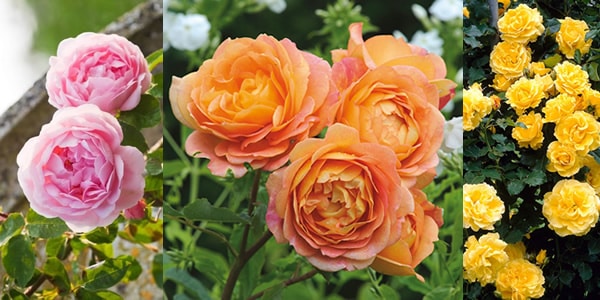Containerised Roses can be planted at any time of year. They are bare-root roses placed in pots of potting media to prevent them drying out. They should be planted as soon as received. Personally, I think late summer/autumn is a great time to plant as it enables newly planted roses to get their roots well established before they shut down for the winter. Then, come spring, they are ready to explode with new top growth and have the advantage of well-established root system capable of handling the new canes and blooms.
Here are some tips to planting, pruning and caring for roses in the garden:
Planting roses…
Aside from times of extreme weather, roses can be planted at any time during the year. The extreme weather conditions that we advise against planting are when the ground is frozen, water-logged or during a drought. Often people ask, ‘when is the best time to plant’, but as long as you avoid the conditions mentioned, there really is no one best time to plant.
- In the area where the rose or roses are to be planted, mix in some well-rotted organic compost, forking it into the top 20-30cm of soil. Farmyard manure is ideal for this such as Levington Organic Blend Farmyard Manure (50ltr bag for £5.49).
- Apply general fertiliser over the surface of the planting area and fork it into the same depth as the organic matter. NOTE: if you are using a mycorrhizal fungi (e.g. Rootgrow) then it is best not to apply a fertiliser at all as phosphorus (found in general fertilisers) can suppress the fungus.
- For each rose dig a hole roughly twice the width of the plant’s roots and the depth of a spade’s blade.
- Carefully tease out the roots of the container plants because, if this is not done, the roots may be very slow to extend outwards, leaving the young plant more susceptible to drought in summer.
- Place the rose in the centre of the hole and, using a small cane to identify the top of the planting hole, ensure the graft union (i.e. where the cultivar joins the rootstock and the point from which the branches originate) is at soil level (not below as this is reported to increase the risk of rose dieback).
- Back-fill gently with the excavated soil and organic mixture.
- If you are replacing old roses with new roses, ensure that you dig out the soil to a depth and width of 45cm (18in) and exchange it with soil from a different part of the garden, as roses are at risk from replant disease, also known as soil sickness. We would recommend using Rootgrow as it is recommended to help combat replant disease.
Where to plant rose…
- Ensure plenty of sunlight – Roses thrive on direct sunlight. For best results, a minimum of four hours of direct sunlight is recommended. However, even when planted against a north wall (meaning no direct sunlight) roses can still perform well. Roses such as ‘Constance Spry’, ‘Lady of Shallot’ and ‘Golden Showers’ are great for shaded areas.
- Avoid intense competition from other plants – the closer you plant your rose to other plants, the more competition there is for moisture and sunlight. For best results, plant your rose 3 feet (100cm) away from other plants and 2 feet (60cm) from other roses. Avoid planting a rose under an overhanging tree branch.
- Avoid very exposed, windy sites – strong winds can cause the base of the rose to loosen in the soil. This will result in your rose rocking in the wind which will lead to it growing at an angle, which in extreme cases will kill it.

Rosa ‘Constance Spry’, ‘Lady of Shallot’ and ‘Golden Showers’
Pruning…
Prune back in the first winter after planting. Do this in late winter or early spring. With all roses, first remove dead, damaged and weak growths, then:
– Hybrid tea (large-flowered): Prune the remaining strong stems hard back to 10-15cm (4-6in) from ground level
– Floribunda (cluster-flowered): Prune the remaining strong stems moderately hard back to about 15cm (6in) from ground level
Ramblers and climbers: Prune remaining strong stems back to 30-40cm (1ft-15in) from ground level if not already pruned at the nursery (climbing sports of bush varieties may revert to bush type if pruned back hard)
Shrub and species roses: Leave remaining strong stems unpruned.
General care
Feeding: Apply a dressing of a general or rose fertiliser every spring such as Toprose or David Austin Rose Food to promote healthy foliage and generous flowering. If growth slows, repeat the fertiliser application in mid-summer. Plants can be sprayed with Rose Clear to control pest and disease problems should they occur.
Mulching: Follow feeding immediately with mulching, in a layer of up to 8cm (3in) deep. Keep the mulch clear of the rose stems, leaving a 10cm (4in) gap between the mulch and stems. We recommend using Strulch Organic Straw Mulch as it lasts on the surface for up to two years and does not rob nitrogen from the soil so plants stay healthy. It works by blocking out the light. It has a neutral pH so can be used anywhere in the garden AND it has a slug and snail deterrent within it. The deterrent irritates the slugs and snails – they don’t eat it and so it doesn’t enter the food chain. One 100 litre bag spreads 3m². All in all, Strulch is excellent value and that is why The Eden project and the RHS use it!
Watering: Water well in dry spells for at least two summers after planting.
To find out more about roses and their colour meanings please see our ‘Language of Roses’ article.









